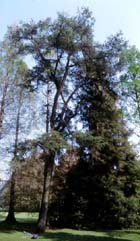
Tree at Huntington Botanical Gardens, California [C.J. Earle, 2001.03].
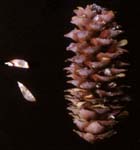
Cone and seeds from above tree [C.J. Earle, 2001.03].
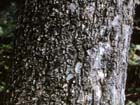
Bark of above tree [C.J. Earle, Mar-2001].
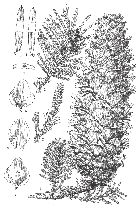
Line drawing; for full size image go to the Flora of China (Wu and Raven 1999).
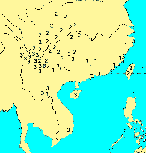
Distribution; K. evelyniana collections numbered "3" (Farjon 1989).

Keteleeria evelyniana
Masters 1903
Common names
Yunnan youshan (Chinese) (Farjon 1990); Du sam, May hinh (Vietnamese) (FIPI 1996).
Taxonomic notes
Syn: K. delavayi Van Tieghem 1891; K. dopiana Flous 1936; K. roulletii Flous 1936; K. hainanensis Chun et Tsiang 1963; K. evelyniana var. pendula Hsueh 1983. Farjon (1989) provides a thorough taxonomic review of the species.
Description
Trees to 40 m tall and 100 cm dbh. Bark grayish brown, irregularly and longitudinally fissured, flaking. Branchlets reddish or brownish red, turning brown, usually initially pubescent, glabrous in 2nd or 3rd year. Leaves narrowly linear, slightly falcate, (2-)4-6.5 cm × 2-3.5 mm, stomatal lines (0-)4-20 adaxially, 28-38 in each band abaxially, apex mucronate. Seed cones cylindric, (7-)9-20(-25) × (3.5-) 4-6.5 cm. Seed scales at middle of cones rhombic-ovate, (2-)3-4 × (2-)2.5-3 cm, exposed part of abaxial surface pubescent or nearly glabrous, apex subacute, erose-denticulate. Seeds oblong, 0.9-1.4 cm × 5-7 mm; wing yellowish brown, semitrullate. Pollination April-May, seed maturity October (Wu and Raven 1999).
Distribution and Ecology
Laos, Vietnam (as far south as the Plateau of Langbian near Dalat), and China: W Sichuan, Yunnan (where it probably intergrades with K. davidiana), and W Guizhou; at 700-2900 m elevation (Wu and Raven 1999). Farjon (1990) also places it in the central mountains of Hainan. Hardy to Zone 8 (cold hardiness limit between -12.1°C and -6.7°C) (Bannister and Neuner 2001).
It grows NW Vietnam at elevations above 600 m and is shade intolerant, prefers neutral or limestone soils, and is typically associated with Pinus spp. or with species of Fagaceace and Lauraceae, in some places being the dominant species (FIPI 1996, as K. davidiana).
Remarkable Specimens
Ethnobotany
Used in construction, railroad ties, mine timbering and sundry house implements. The seeds are rich in essential oil that can be used for burning and soap manufacturing. The tree can also be used in medicine (Wang 1961).
Observations
I have no definite information on this, but judging from the species' ecological requirements and the distribution of historical collections (Farjon 1989), I suspect that it can be found in some of the forest preserves of the Dali - Lijiang area of Yunnan, and perhaps in more northerly preserves in Sichuan such as Hailuogou Glacier Park in the Daxue Shan. All of these areas are relatively accessible in the political and logistic senses.
Remarks
Citations
Farjon, Aljos. 1990. Pinaceae: drawings and descriptions of the genera Abies, Cedrus, Pseudolarix, Keteleeria, Nothotsuga, Tsuga, Cathaya, Pseudotsuga, Larix and Picea. Königstein: Koeltz Scientific Books.
See also
The species account at Threatened Conifers of the World.
Hiep et al. 2004.
Luu and Thomas 2004 provide a recent description, range map, conservation status, drawings and photos, and a wealth of additional information.
Masters, M.T. 1903. Keteleeria evelyniana Masters spec. nov. Gard. Chron. ser. 3, 33:194.
Wilson, E.H. 1926. The taxads and conifers of Yunnan. Journal of the Arnold Arboretum 7:37-68.





